Matthew Boyd is extreme. Now, I want to make sure that I get across what I mean by extreme. He is not extreme in the way that Tony Hawk is extreme, and he is certainly not extreme in the way that, say, skydiver Felix Baumgartner is either. No, Matthew Boyd is extreme in the manner in which he pitches. In 2017, Boyd was, well, extremely bad. He finished the year with a 5.27 ERA, and his xFIP was the 14th worst in the MLB (>130 IP). In 2018, he was much more encouraging, and he’s really leaned into his extremeness.
It is first important to note that it’s difficult to read into his overall 2018 numbers too much. There is context to be had. Here’s his fastball velocity, from the beginning to end of 2018:
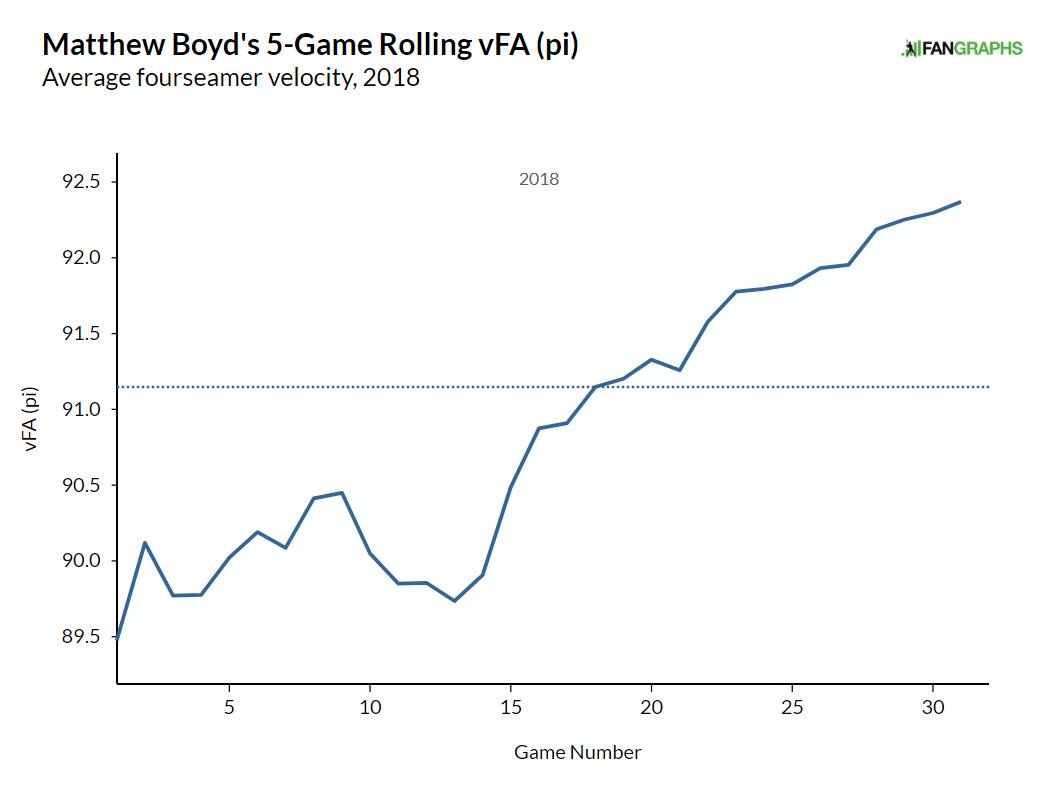
In 2015, Boyd averaged a 92 mph fastball. In 2016, it averaged 92. In 2017, it averaged 92! In 2018, though, his fastball was a far cry from 92 for most of the season. There’s our context.
But that isn’t the only thing going on with his velocity. Early on in the season, Boyd and the Tigers’ pitching staff spoke about varying the speeds of his pitches. Here are his pitches plotted, to show the horizontal and vertical movement of them, via Texas Leaguers:
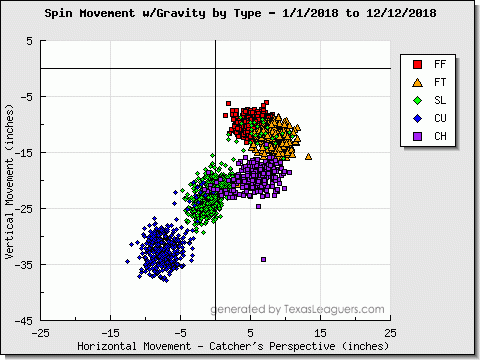
Boyd has a curveball and slider — we know this — but he has sprinkled in separate versions of each as well. A curveball that moves like his slider, and a slider that moves like his fastballs. The catch, though, is the differences in velocity. Here are his pitches in 2017 and 2018, plotted by velocity and spin angle:
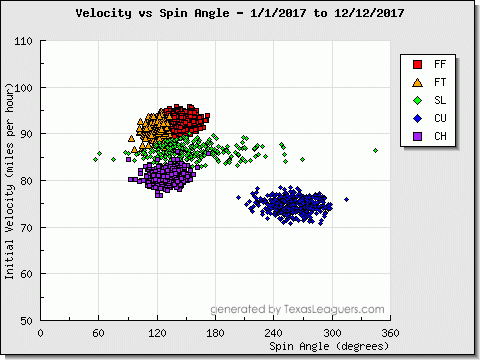
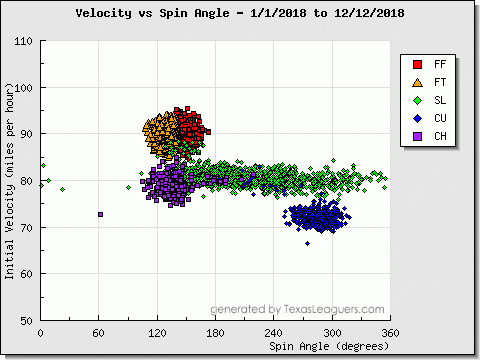
Boyd has varied the spin of his slider a great deal more, and you can see he’s toyed with the velocity here as well. Boyd has a slow slider that he pairs with a faster slider and a curveball that he pairs with a faster curveball. In this way, he is not unlike Patrick Corbin, but in most other ways, he is very much unlike Patrick Corbin. I’ve placed Corbin and Boyd’s plots side-by-side, Corbin’s on the left, and Boyd’s on the right.


To me, there are a couple key differences here. First, Corbin has two distinct groupings of pitches. His changeup acts as a slow version of his fastballs, as it moves similarly, but is slower. That’s… incredibly common! But for Corbin, his curveball is to his slider what his changeup is to his fastballs. They move similarly, but the curveball is slower. For Boyd, it’s messier. His changeup overlaps with his slider, and his curveball has different movement than his slider. Here’s the pair plotted again by velocity and spin angle, with Corbin on the left and Boyd on the right:
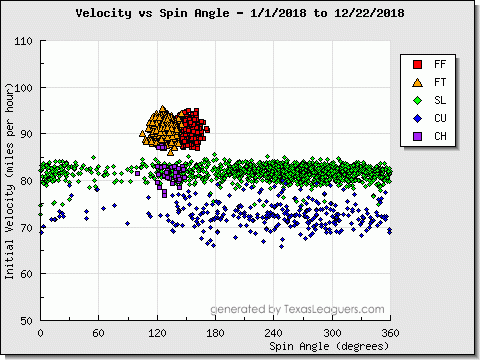

You can see that the two are incredibly similar across the board in repertoire, velocity, and movement. Corbin has simply learned to make his slider and curveball more heterogeneous than the 2017 version of himself as well as Boyd. That is, Corbin’s slider has a lengthier band on the low spin angle side, and a much more diverse band for his curveball as well.
Now, Boyd has experimented with his slider before. In the four years that he’s pitched, he’s had four sliders, all differing in velocity and movement. But the 2017 and 2018 versions of his slider are vastly different. In 2017, Boyd introduced a faster, harder breaking slider. At about 86 mph, it was the 22nd fastest slider in the league (>130 IP). It was bad! So, so very bad. Boyd spent the offseason reworking it into a slower slider at Driveline Baseball — and boy is it slow. It’s the ninth-slowest slider in the MLB. Here are his pitch velocities over the span of the past three years:
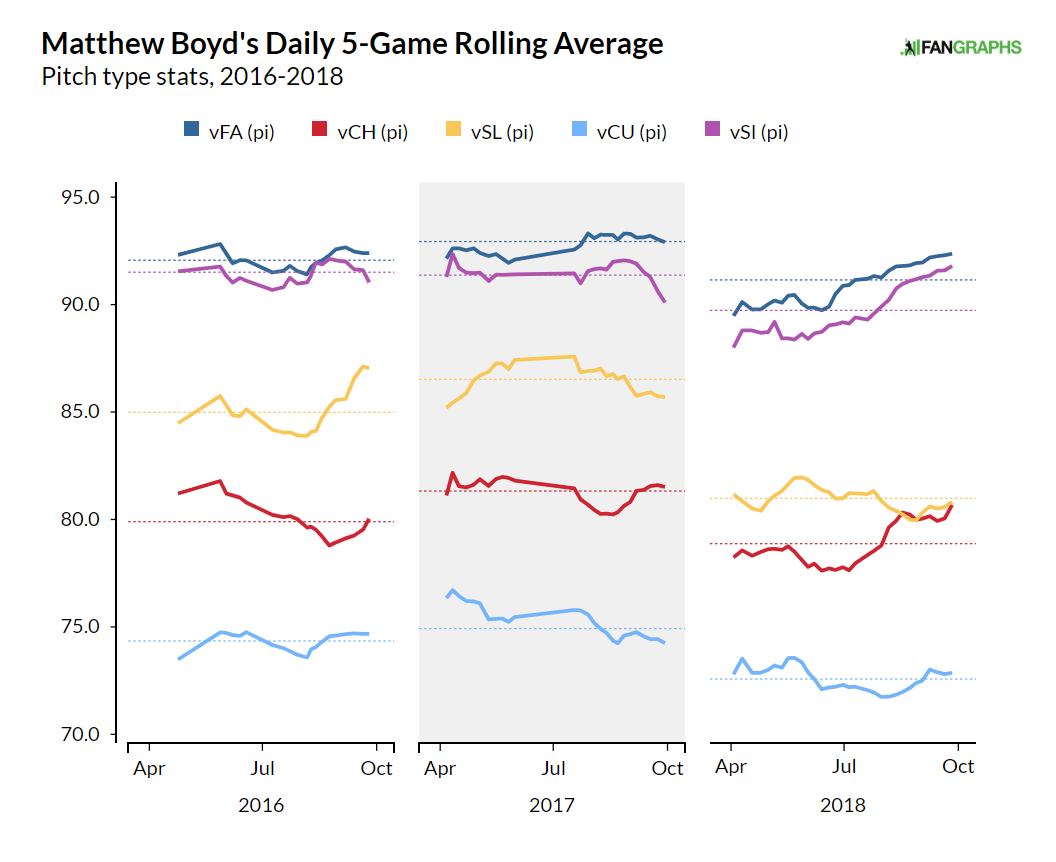
You can see decreases in velocity across the board in 2018, but the change to his slider is drastic. Now instead of four tiers of pitches grouped by velocity, it’s more like three, and he has the faster slider and faster curveball to work in as well. Last year Boyd’s slider was a detriment — his 2017 slider ranked third-worst in the league — while in 2018 it was one of the best in the league, ranking ninth in the league, via wSL/c.
It makes sense, then, that Boyd would want to use a good pitch more. Here’s how he’s utilized his pitches over the past four years, courtesy of Baseball Savant:
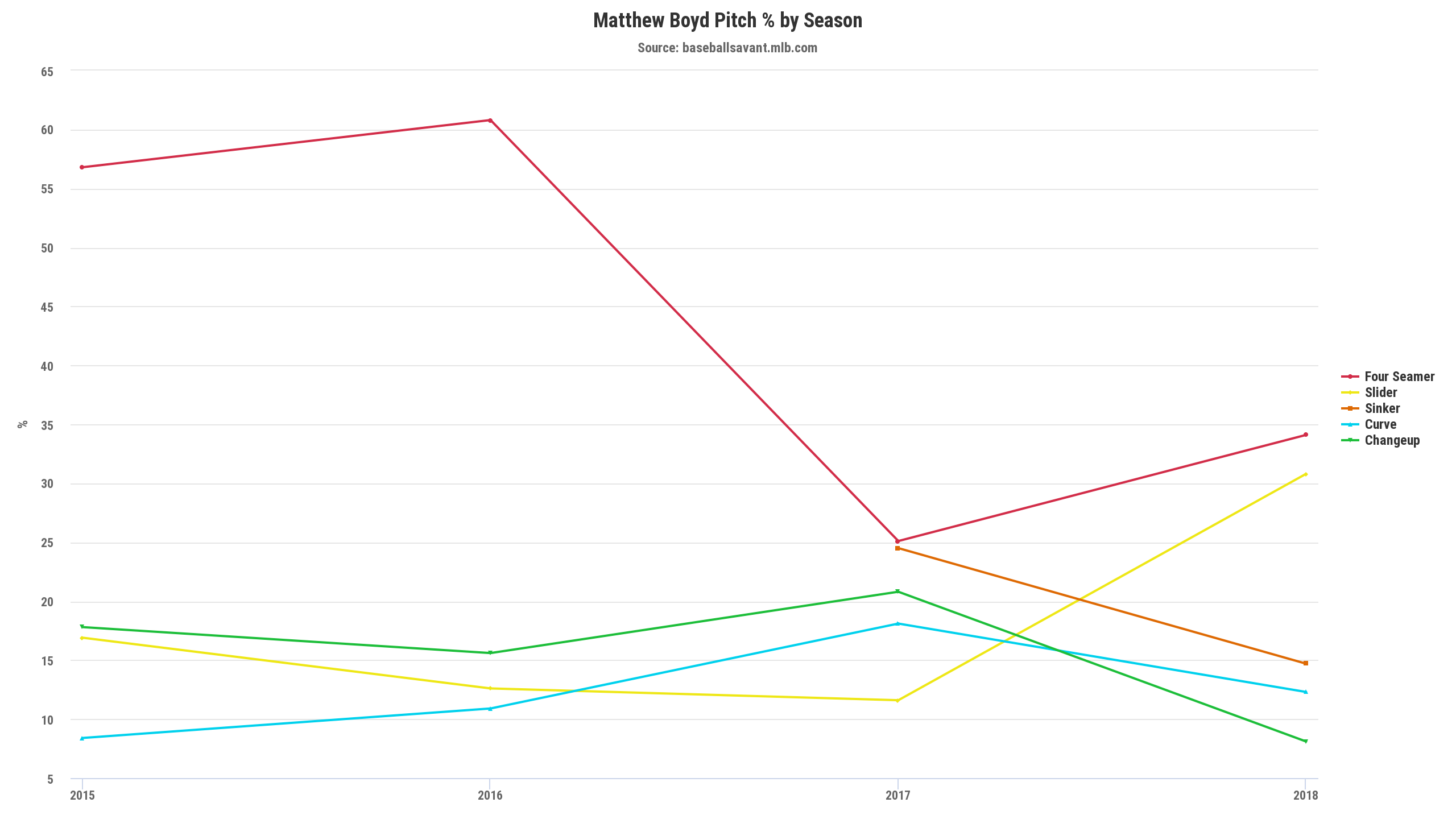
Boyd has always mostly thrown his fastball. In 2015 and 2016, he was a mostly four-seam fastball guy. In 2017, he was a four-seam/sinker guy. In 2018, Boyd ditched his sinker in favor of his slider, and he actually threw his slider more than his four-seamer in May and September. Boyd threw his slider 31.1% of the time in 2018. That’s a lot, and it’s the sixth-most utilized slider in the MLB. That’s extreme! In doing so, he became a fastball/slider guy.
This is a new Boyd, but it is not yet a *good* Boyd. The changes are fun, and they are needed, but there were many things about 2018 that still need tightening up.
First, Boyd is a fly ball pitcher, no doubt. In 2017, his average launch angle was 14.8 degrees, which surely isn’t unprecedented. It ranks him 110th of 438 pitchers. But in 2018, his average launch angle jumped massively to 21.8 degrees, 12th of 436 pitchers. That is a massive jump, going from 110th in 2017 to 12th in 2018. Here’s how it changed his profile:
| Year | GB/FB | LD% | GB% | FB% | HR/FB |
| 2017 | 0.96 | 22.3% | 38.1% | 39.5% | 10.6% |
| 2018 | 0.58 | 21.1% | 29.0% | 49.9% | 11.2% |
That’s a good chunk of information to take in, but generally speaking, this isn’t good. Fly balls are good until they’re home runs. Boyd had a lot of fly balls, and many of them turned into home runs. His 1.43 HR/9 ranks eighth worst of qualified pitchers and his 29.0% GB% is the second-lowest in the league. Unfortunately, it isn’t anyone pitch that’s getting lifted. Four-seam fastballs are generally a fly ball pitch, but *all* of his pitches’ launch angles are up, as well as their fly ball rates.
This is all working just fine for Boyd in Comerica Park, where he has a 2.63 ERA, but on the road, Boyd’s ERA is a horrid 5.89. Overall, there are very few changes in his profile between home and road starts. It’s largely just those pesky dingers. At Comerica, Boyd has an admirable 0.92 HR/9, but for road starts that spikes to a 1.87 HR/9. These numbers are — dare I say — extreme.
Somewhere in 2018, there was a good Boyd. I picked July 10th, when Boyd’s fastball finally reached and maintained 90 mph, to September 8th, where shortly thereafter he unraveled in the last three starts of the season. A table:
| K% | BB% | HR/9 | ERA | FIP | xFIP |
| 25.90% | 4.50% | 1.20 | 3.46 | 3.52 | 4.18 |
This K-BB% profile is a top-15 profile, and the HR/9 is far more manageable. He struck out hitters like Mike Clevinger, and walked them like Mike Leake. Of course, he didn’t look like this for most of the year. Many bad pitchers have been good for long stretches of time. Matthew Boyd could be no exception. But for two months, Boyd showed that he could hack it with the best of them.
Boyd has a lot to clean up, but this all feels like a good foundation. We didn’t get a full year of this Boyd, because, for 17 games, he wasn’t even throwing 91. For that reason, it seems like a disservice to dissect Boyd without the proper context. Whatever the explanation may be, he lost his velocity, but now he has it back. For a lefty in the low-90s, that’s a big deal. The home runs are always going to be a problem, but for Boyd, the hope is to turn them into less of a problem. Corbin leaned into being extreme in his pitch mixing. It will be interesting to see if Boyd continues to do the same.
(Photo by Cliff Welch/Icon Sportswire)


Nice article.
Has anyone ever told you that your bio is incredibly similar to Jeff Sullivan of Fangraphs?
“Jeff made Lookout Landing a thing, but he does not still write there about the Mariners. He does write here, sometimes about the Mariners, but usually not.”
Yikes! Thanks for letting me know. I’ve been following Jeff since his Lookout Landing days, so his byline clearly influenced mine. I’ve made some changes to mine to reflect that.
Thanks for this insight into Matt Boyd, I decided to select him in my dynasty startup today as a result of this article and the changes to his slider and pitch selections
Woo! Glad I could be of service.